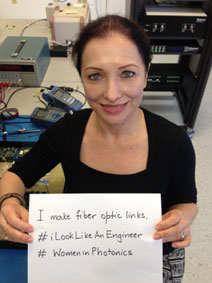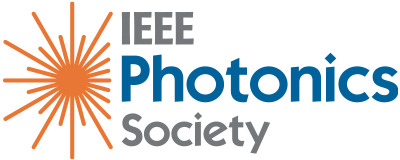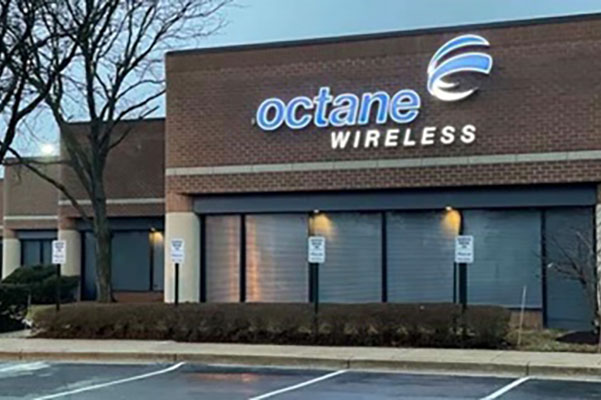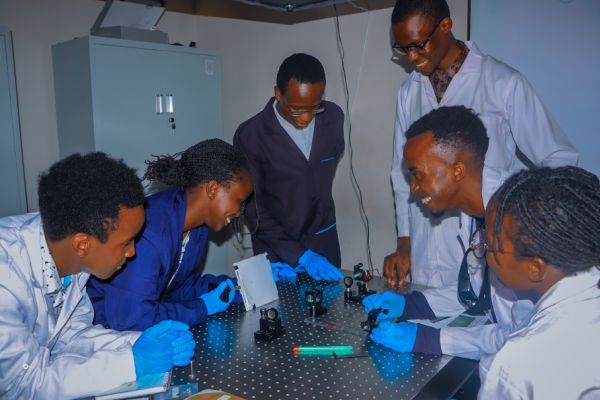By Dalma Novak
In this edition of the Industry Engagement column, we talk with Dalma Novak, the current Chair of the Photonics Society’s Industry Engagement Committee.
What is your current professional job?
I am VP of Engineering at Octane Wireless which is located in Hanover, Maryland. We are a small company developing antenna and fiber optic remoting technologies for commercial and defense applications.
As someone who has transitioned from academia to industry, can you give some background behind that journey?
I completed my Ph.D. at The University of Queensland, Australia in 1991 and in the following year, joined the Department of Electrical and Electronic Engineering at The University of Melbourne working in the Photonics Research Laboratory with Prof Rod Tucker. My research group was investigating the generation, modulation, and distribution of very high-frequency RF signals for next-generation wireless systems. In mid-2000 I traveled to the US to undertake a sabbatical, first spending time at UCLA with Prof Ming Wu, and later I was based in Washington, DC at the Photonics Technology Branch of the Naval Research Laboratory (NRL). At that time there seemed to be almost weekly farewell lunches for departing NRL researchers. I was encouraged by some of these colleagues to also interview with several local start-up companies as there was a big demand for photonics technologists. In the end, I was offered positions at two MD-based start-ups and decided to join a venture-backed company based in Columbia, Maryland that was then in stealth mode but would later become Dorsál Networks.

Was it a difficult decision to leave the University?
It was, especially as it involved relocating to a new country in addition to switching careers. I had always thought of the possibility of moving overseas to gain additional experience but had never contemplated leaving academic life. I was able to offset some of the risk (and anxiety) by negotiating a leave of absence from the University of Melbourne so that I wouldn’t have to give up the security of a tenured academic position, although the transition still meant that I was effectively starting from scratch with regards to my career development.
What did you work on at Dorsál Networks?
The company was building the first submarine fiber-optic network that incorporated Raman amplifier technology to achieve ultra-high-capacity, ultra-long haul data transmission. I was assigned to be Technical Lead of the Wavelength Division Multiplexing (WDM) group, a small team of optical Ph. D.s tasked with designing the optical networking hardware. Within the company, other groups were focused on developing the undersea optical amplifier and the submarine terminal equipment, as well as demonstrating the transmission concepts. Many of the 100 or so other employees had technical backgrounds: electrical engineers and physicists with Ph. D.s, electrical designers, as well as firmware, mechanical, software, reliability, and quality engineers. Later, the company decided to refocus the engineering teams so I was then assigned to lead an interdisciplinary team developing WDM terminal equipment that could be added to customer’s existing undersea optical systems.

How did you find the transition to industry?
Challenging, fast-paced, and stressful, but also very exciting and rewarding! Everyone was working very long hours to get the equipment built and I was dealing with all sorts of issues that I had never confronted before, related to realizing a product. In addition to learning about the company’s technology, I received a crash course in product development. I was quickly educated about what was required to develop a product that met stringent specifications as well as the various stages involved in getting an idea from concept to manufacturing through to market release. I also learned about the importance of documentation in every step of the process. I learned a huge amount in a short space of time.

What happened to the company?
At the start of 2002 Dorsál Networks was acquired by Corvis Corporation as a strategy by Corvis to expand its market since Corvis was focused on selling land-based equipment. This purchase also provided a much-needed injection of funds to keep Dorsál’s product development going while looking for customers.
In an effort to get a product to market as soon as possible, the group developing the Raman-based undersea optical amplifier was reassigned to my team developing the WDM terminal equipment. We did end up successfully developing and testing the terminal equipment but the hardware that we all had worked so tirelessly on was immediately shrink-wrapped and put into warehouse storage. As the saying goes, timing is everything, and unfortunately, it was now our turn to experience the end of the telecoms boom.
What was your next career move?
At the end of 2003, my husband and I had an opportunity to start our own company in partnership with a former colleague from Dorsál/Corvis. We focused the new business on developing products based on our particular technical expertise, microwave photonics and antennas/RF communications. As we already had a consulting company in Melbourne called Pharad (a combination of photonic and radio which rhymes with Farad) we opted to use the same name for the new company. A few years ago, the company name was changed to Octane Wireless. When we started Pharad/Octane Wireless we all agreed that we wanted to avoid seeking external funding to support the company. While we all enjoyed our experience at Dorsál/Corvis, we were also somewhat disillusioned by the consequences associated with venture capital financing. To get the company off the ground, we essentially leveraged our academic experience to write successful grant proposals. We were fortunate to be able to apply for US federal government funding through the Small Business Innovation Research (SBIR)/Small Business Technology Transfer (STTR) program, which provides funding for early-stage, high-risk innovation ideas being undertaken by small businesses. Eventually, our new company received its first R&D contract and we started to build the business. Although I ended up resigning from The University of Melbourne, I was later appointed as a Professorial Fellow in the Electrical and Electronic Engineering Department which allowed me to continue collaborating with other researchers. Our company has certainly evolved over time. We are now sufficiently well-known and trusted that customers approach us directly to solve their problems and our core business is now much more focused on product development and commercialization than R&D programs.

What does your work involve now?
Our two key product areas are RF over Fiber technologies and Antennas. The goal in establishing our own company was always to commercialize our technology, so we focused our efforts on creating products to be manufactured and delivered to our customers. The many R&D contracts that we were successful in obtaining over the years allowed us to recruit engineers from multiple disciplines as well as establish our own on-site production facility. Our funding approach meant that it took longer to commercialize our products, but now that we are mature with well-established production processes and supply chains, we are able to respond very quickly to customers. Within the company I oversee the design and development of a range of hardware for implementing RF over Fiber links, including RF transmitters and receivers operating up to 50 GHz for wireless communications and modulator bias controller circuits for OEM applications. For defense applications we also develop high performance (high linearity, low noise figure) fiber optic links for remoting surveillance signals. Recently, we had the opportunity to flight test some of the fiber remoting hardware that we had developed for a government customer.

One aspect of being in a small company is that you invariably wear multiple hats, and that is especially true when you are also an owner of the business. That also means continuing to learn and acquire new skills. In addition to providing technical leadership in the company I also oversee the operations of our manufacturing facility and manage quality compliance. I also interface directly with customers and participate in sales and marketing activities. Since the company began, I have learned a lot about running a business and developed skills that I would not necessarily have acquired in a larger enterprise. I have always embraced taking on new responsibilities and the learning that goes along with that. I believe the more you know about all aspects of what your organization does, the more successful outcomes you can achieve.
Do you see any parallels between life as an academic and industry professional?
I see quite a few parallels, but I think that will also depend on your role in the company, its size, and how it operates. There is a definite connection between the skills I was using at the university to be an effective academic (writing proposals, seeking funding, building a technical team) and those I used to start a technology business. Also, I do still educate others, but instead of teaching students I provide my technical knowledge to other professionals and customers.
Outside of your professional life, you are an active volunteer for the IEEE. Why do you think it’s important to get involved?
The IEEE and the Photonics Society have been my career partners ever since I joined as a student more than 30 years ago. I’m a strong proponent of putting back into the technical community and I believe the more you are actively engaged, the more you get out of your membership. The formal definition of a volunteer is someone who freely offers to take part in an enterprise or undertake a task. Looking back on my IEEE volunteer career, however, I typically got involved because I was invited to take part and then usually said yes. Every different volunteer opportunity has brought a new and valuable dimension to my life and I’m always encouraging others to do the same.
What is the role of the Society’s Industry Engagement Committee?
The committee was established to support the development of programs and activities that enhance the experience and engagement of the Society’s members and the wider community working in industry. It also aims to encourage entrepreneurship within the photonics community and increase the engagement of industry members with the Society’s many activities, including the Distinguished Lecturer Program. A major initiative of the committee has been the Industry Day event which is now an integral part of the Society’s annual IEEE Photonics Conference (IPC). The IPC Industry Day includes industry professionals contributing to a day-long program that is a mix of talks and panel sessions, with a different theme for each. Although approximately half of the Society’s membership are professionals working in industry, there are far fewer industry-based volunteers. The committee is also striving to increase the active participation of industry members in the operation and governance of the Society to help bring new perspectives and strategic visions that will ensure its continued vitality.
About The Author

Dalma Novak is VP of Engineering at Octane Wireless. Previously she was a Professor in the Department of Electrical and Electronic Engineering at The University of Melbourne and also led cross-disciplinary R&D teams developing WDM hardware for longhaul transmission systems at Dorsál Networks and Corvis Corporation. Dr. Novak received the degrees of Bachelor of Engineering and PhD in Electrical Engineering from the University of Queensland. She is a Fellow of the IEEE and recognized internationally in the areas of microwave and millimeter-wave photonics. In 2018 she received the IEEE Photonics Society Engineering Achievement Award. Dr. Novak is a member of the IEEE Board of Directors as Director of Division X for 2021 – 2022. She is also the current Chair of the IEEE TAB Committee on Diversity and Inclusion as well as Chair of the IEEE Photonics Society Industry Engagement Committee. She was President of the Society during 2014–2015.
About This Column
This is a regular column that explores business aspects of technology-oriented companies and in particular, the demanding business aspects of photonics startups. The column touches on a broad range of topics such as financing, business plan, product development, program management, hiring and retention, manufacturing, quality, sales methodology and risk management. That is to say, we include all the pains and successes of living the photonics startup life.
This column is written sometimes by Daniel Renner, the column editor, and sometimes by invited participants, so that we can share multiple points of view coming from the full spectrum of individuals that have something to say on this topic. At the same time, this is a conversation with you, the
reader. We welcome questions, other opinions and suggestions for specific topics to be addressed in the future. Please send us your views and opinions to ipsnewsletter@ieee.org.
The expectation for this column is to provide useful business-related information for those who intend to start, join, improve the operation, fund, acquire or sell a photonic startup. A fascinating area that can provide enormous professional reward to those engaged in it.




